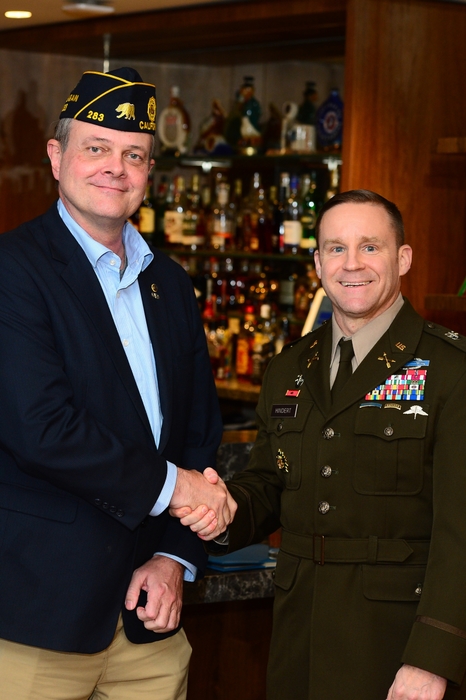
Lt. Col. Johann Hindert spoke at Ronald Reagan American Legion Post 283.
Photo: RICH SCHMITT/Post 283
Your kid is in high school. He/she is not thrilled about competing academically and many classes seem like a waste of time to him/her. The only avenue the school seems to push is four-year colleges or community college.
On March 20, Lt. Col. Johann Hindert, explained to an audience at the Ronald Reagan American Legion Post 283 that when he decided to join prior to 911 “I wanted a job that was physical. I wanted something intellectually challenging, and I wanted a job to take me places I wouldn’t normally see.” He joined the Army.
Why don’t more kids consider the Army? Post 283 Commander James Cragg, summed it up “those in the service are shown as broken people in movies and television. We’re not like the people they are portraying.”
Hindert, a special forces officer, said there are about 200 career paths for those who seek out a career in the Army.
People are allowed to choose between nine categories, which include 1) Science and Medicine (with more than 104 jobs to choose from), 2) Intelligence, 3) IT & Cyber, 4) Mechanics and Engineering, 5) Support, 6) Logistics, 7) Aviation (helicopters and unmanned aircraft systems), 8) Leadership and Tactical, 9) Law and Legal.
Hindert said that although there is a reduction in troops, the Army is working to become smaller and more agile, more able to address today’s hot spots. “It is a historic transformation to address an evolving threat environment,” he said.
Many people might think the Army is only about combat, rather it is expanding its STEM (Science, Technology, Engineering and Math). Hindert said there are 30 new or upgraded technical systems across six modernization portfolios, which include long-range precision fires and missile defense.
The Army is also expanding its air defense, cyber and electronic warfare capabilities. In that process, the scale of intelligence gathering will increase, and non-kinetic space and cyber effects will support operations.
If a person enlists and then doesn’t like the route they are going, there is flexibility to change.
Benefits include comprehensive health care and dental care. The Post 9/11 GI Bill provides 100 percent tuition and fees and housing allowance. There are 30 days of paid vacation a year and 12 weeks of parental leave.
The Army also offers $4,000 in annual tuition assistance support, which can be applied to a variety of degree and certification pursuits. There are also special pay allowances and bonuses and when a vet goes to buy a home that may include lower interest rates, a zero-down payment, no mortgage insurance required, and the VA guarantees a portion of the loan.
The Army provides $65k in college loan repayment and a school like Stanford honors the yellow-ribbon program. That program can help pay for higher out-of-state, private school, foreign school or graduate school tuition and fees that the Post-9/11 GI Bill may not cover.
Hindert said the Army is also considering older people – late 20s, early 30s, such as maybe the Amazon worker, who finished college and is trying to pay off his debt in a job that doesn’t excite him.
Hindert said that even though the Army is reducing numbers, there is a problem with recruitment.
“Less than 25% of Americans between the ages of 17 – 24 even qualify for military service based on a number of physical health, cognitive, and moral standards,” he said, but noted that the Army is not lowering its standards.
One way it has addressed the issue is to set up a future soldier preparatory course at Ft. Jackson. “The students benefit from quality food, sleep, fitness, and instruction,” Hindert said. “The conversion is amazing.”
He said that “we serve as a trusted team of professionals that offers young men and women of life-changing Army career pathways.”
The downside? According to Cragg, who is still active, one shouldn’t always believe what the media portrays about the Armed Forces.
For more information about Army recruiting, contact: Sergeant First Class Carlos Burgos at carlos.s.burgos2.mil@army.mil or (442) 354-1969 or (818) 401-2773.

